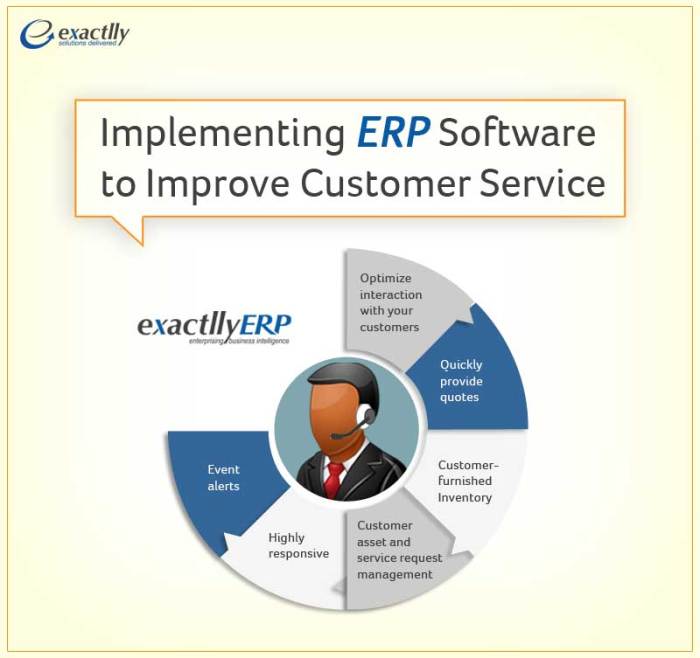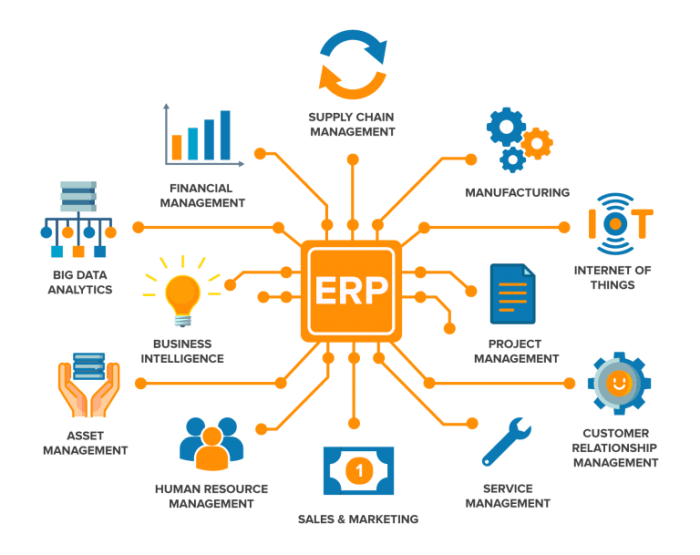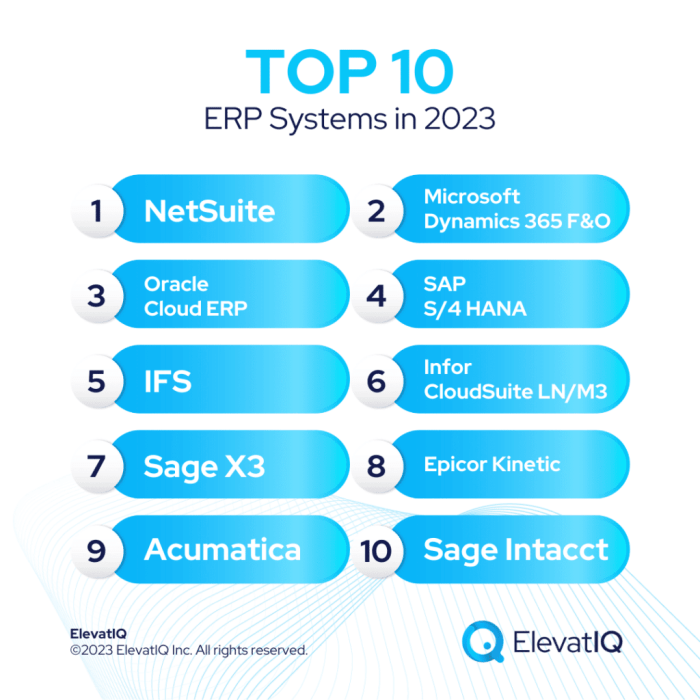Best ERP solutions for service-based businesses with high customer interaction are essential for managing the unique challenges and opportunities of these businesses. These businesses rely heavily on customer relationships, personalized service, and real-time communication. ERP systems streamline operations, enhance customer service, and provide valuable functionalities like customer relationship management (CRM), project management, and service delivery tracking.
For example, a customer service company can use an ERP system to track customer interactions, manage service requests, and measure service performance. This information can be used to improve customer satisfaction, reduce costs, and enhance operational efficiency.
Understanding Service-Based Businesses with High Customer Interaction
Service-based businesses thrive on the strength of their customer relationships. These businesses often operate in industries where the product is intangible and the service itself is the core value proposition. They face unique challenges and opportunities due to the high volume of customer interactions that are essential to their success.
Characteristics of Service-Based Businesses with High Customer Interaction
The success of these businesses depends heavily on building and maintaining strong customer relationships. Personalized service is paramount, as customers seek tailored solutions and individual attention. Real-time communication is critical to address customer needs promptly and efficiently.
- Customer-centricity: Service-based businesses with high customer interaction prioritize understanding and meeting customer needs. They invest in customer relationship management (CRM) systems and customer service strategies to build lasting relationships.
- Personalized Service: These businesses tailor their services to individual customer preferences and requirements. They leverage data and technology to personalize interactions and provide customized solutions.
- Real-time Communication: Prompt and efficient communication is essential for these businesses. They utilize various communication channels, such as email, chat, phone, and social media, to ensure real-time engagement with customers.
Examples of Industries and Business Models
Many industries fall under this category, with examples ranging from professional services to healthcare.
- Professional Services: Consulting firms, law firms, accounting firms, and marketing agencies are all service-based businesses with high customer interaction. These firms rely on building strong relationships with clients to deliver customized solutions.
- Healthcare: Hospitals, clinics, and healthcare providers heavily rely on customer interaction. Patient care requires personalized attention, real-time communication, and efficient coordination across departments.
- Education: Educational institutions, including universities, colleges, and training centers, rely on student engagement and interaction. Effective communication, personalized support, and real-time feedback are crucial for student success.
- Customer Support: Businesses with large customer bases often have dedicated customer support teams. These teams handle inquiries, resolve issues, and provide assistance, ensuring customer satisfaction and loyalty.
The Role of ERP in Service-Based Businesses

ERP systems are essential tools for service-based businesses, especially those with high customer interaction. They offer a centralized platform to manage various aspects of operations, leading to improved efficiency, customer satisfaction, and profitability.
Streamlining Operations and Enhancing Customer Service
ERP systems streamline operations by integrating different departments and processes, ensuring data consistency and real-time visibility. This integration allows for efficient workflow management, resource allocation, and task automation. For instance, an ERP system can automate appointment scheduling, track service requests, and generate reports on service delivery performance, all while providing real-time insights into customer interactions. This information can be used to optimize service delivery, identify areas for improvement, and personalize customer experiences.
Key Features to Look for in ERP Solutions
For service-based businesses with high customer interaction, choosing the right ERP solution is critical for optimizing operations and enhancing customer experience. A comprehensive ERP system should integrate seamlessly with your existing systems and offer a suite of features designed to streamline service delivery, manage customer relationships, and improve overall efficiency.
CRM Integration
Integrating a CRM system with your ERP is essential for managing customer interactions effectively. A seamless integration allows you to:
- Centralize Customer Data: Access a unified view of customer information, including contact details, purchase history, service requests, and communication logs, from a single platform. This eliminates data silos and provides a holistic understanding of each customer.
- Streamline Customer Interactions: Automate tasks like lead generation, opportunity management, and customer support, reducing manual effort and improving response times. For example, when a customer calls for service, the representative can instantly access their past interactions, purchase history, and preferences, enabling personalized and efficient service.
- Personalize Service: Utilize customer data to tailor service offerings and communications. This can include sending targeted promotions, providing customized support, or offering relevant recommendations based on past interactions.
Service Management
A robust service management module within your ERP is crucial for managing service requests efficiently and tracking service delivery effectively. Key functionalities include:
- Request Management: Create, track, and prioritize service requests from various channels, including phone, email, and online portals. This ensures that all requests are captured and processed efficiently.
- Service Level Agreements (SLAs): Define and enforce SLAs for different service types, ensuring timely delivery and meeting customer expectations. This helps maintain service quality and customer satisfaction.
- Service Delivery Tracking: Monitor service delivery progress in real-time, including technician assignments, task completion, and service updates. This provides visibility into service operations and facilitates proactive problem-solving.
- Performance Measurement: Track key service metrics, such as response time, resolution time, and customer satisfaction ratings. This data helps identify areas for improvement and optimize service delivery processes.
Real-Time Communication
Real-time communication features within an ERP system enable seamless collaboration and information sharing among customer service representatives, technicians, and customers. This fosters efficient problem-solving and improves customer satisfaction.
- Instant Messaging: Allow for quick and direct communication between service representatives and customers, facilitating efficient issue resolution and reducing wait times.
- Live Chat: Provide online chat support to address customer queries in real-time, enhancing customer experience and improving engagement.
- Internal Communication: Facilitate seamless communication between service representatives, technicians, and managers within the organization. This ensures everyone is on the same page and can collaborate effectively to address customer issues.
Reporting and Analytics
Comprehensive reporting and analytics capabilities provide valuable insights into customer behavior, service performance, and operational efficiency. This data can be used to:
- Identify Trends: Analyze customer interactions, service requests, and performance data to identify patterns and trends in customer behavior and service delivery.
- Measure Service Performance: Track key metrics such as response time, resolution time, and customer satisfaction to assess service quality and identify areas for improvement.
- Optimize Operations: Analyze data to identify bottlenecks and inefficiencies in service delivery processes. This enables you to streamline operations and improve overall efficiency.
Evaluating and Choosing the Right ERP Solution

Choosing the right ERP solution for your service-based business is crucial for success. It’s not just about finding a system that can handle your finances and operations; it’s about finding a solution that aligns with your specific needs, enhances customer interaction, and supports your long-term growth. This evaluation process involves careful consideration of several factors, including industry-specific functionality, scalability, integration capabilities, and cost-effectiveness.
Industry-Specific Functionality
Choosing an ERP solution with industry-specific functionalities is essential for service-based businesses. This means selecting a system that understands the unique challenges and requirements of your industry, such as customer service, project management, or professional services. For example, an ERP solution designed for a consulting firm might offer features like project tracking, time and expense management, and resource allocation, which are essential for effective service delivery.
Implementing and Optimizing the ERP Solution
Implementing an ERP solution is a significant undertaking for any service-based business. It requires careful planning, effective communication, and a dedicated team to ensure a successful transition. The implementation process involves a series of steps that should be approached strategically to maximize the benefits of the new system.
Data Migration
Data migration is a critical step in ERP implementation. It involves transferring data from existing systems to the new ERP system. A well-planned data migration process is crucial for ensuring data accuracy and integrity, minimizing downtime, and preventing disruptions to business operations.
- Data Cleansing: Before migrating data, it’s essential to clean and validate existing data. This involves identifying and correcting errors, inconsistencies, and duplicate entries. This step ensures data quality and accuracy in the new system.
- Data Mapping: This involves establishing a clear mapping between fields and data structures in the old and new systems. This ensures that data is transferred correctly and can be easily accessed and analyzed in the new ERP system.
- Data Transformation: In some cases, data may need to be transformed or converted to fit the requirements of the new ERP system. This could involve changing data formats, units of measurement, or data types.
- Testing: After migrating data, thorough testing is crucial to ensure that all data has been transferred correctly and is accessible in the new system. This involves running various scenarios and validating the data against the original source.
User Training
Comprehensive user training is essential for ensuring successful ERP adoption. User training programs should be tailored to the specific needs of each user group, providing them with the knowledge and skills to effectively utilize the ERP system.
- Needs Assessment: Conduct a thorough needs assessment to identify the specific training requirements of different user groups. This will help to tailor training programs to the unique roles and responsibilities of each group.
- Hands-on Training: Hands-on training is crucial for allowing users to gain practical experience with the ERP system. This can be done through interactive workshops, simulations, and real-life scenarios.
- Ongoing Support: Provide ongoing support to users after the initial training. This could involve setting up help desks, providing online resources, or offering regular refresher sessions.
Process Optimization
ERP implementation provides an opportunity to streamline and optimize business processes. By analyzing existing processes and identifying areas for improvement, businesses can leverage the capabilities of the ERP system to enhance efficiency and effectiveness.
- Process Mapping: Map existing business processes to identify bottlenecks, redundancies, and areas for improvement. This provides a clear understanding of how processes currently work and identifies opportunities for optimization.
- Automation: Leverage the automation capabilities of the ERP system to automate repetitive tasks and processes. This frees up staff to focus on higher-value activities, improving efficiency and reducing errors.
- Integration: Integrate the ERP system with other business systems to streamline data flow and eliminate manual data entry. This reduces the risk of errors and improves data accuracy.
Case Studies and Best Practices

Seeing how ERP systems have worked for other service-based businesses with high customer interaction can provide valuable insights. Let’s look at some real-world examples and the strategies behind their success.
Successful ERP Implementations in Service-Based Businesses
These case studies showcase how different service-based businesses have leveraged ERP solutions to improve their operations and customer experience.
- Company A: A leading consulting firm implemented an ERP system to streamline its project management, resource allocation, and client billing processes. The system provided real-time visibility into project progress, resource utilization, and financial performance, enabling the firm to optimize resource allocation, improve project delivery, and enhance client satisfaction.
- Company B: A customer service-focused software company implemented an ERP system to centralize its customer support operations, track customer interactions, and analyze customer feedback. The system provided a single platform for managing customer inquiries, resolving issues, and tracking customer satisfaction. This resulted in improved response times, increased customer retention, and a more efficient customer service operation.
- Company C: A professional services firm implemented an ERP system to automate its business processes, including proposal generation, contract management, and invoicing. The system helped the firm to reduce manual tasks, improve efficiency, and enhance accuracy. It also provided real-time financial reporting, enabling the firm to make informed decisions about pricing, resource allocation, and profitability.
Key Strategies and Best Practices, Best ERP solutions for service-based businesses with high customer interaction
These strategies and best practices are essential for successful ERP implementations in service-based businesses with high customer interaction.
- Define Clear Objectives and Requirements: Clearly define the business goals and objectives for the ERP implementation. This includes identifying key areas for improvement, such as customer satisfaction, efficiency, and profitability.
- Choose the Right ERP Solution: Select an ERP solution that is specifically designed for service-based businesses and aligns with the company’s unique needs and requirements. This includes considering features such as customer relationship management (CRM), project management, and service management.
- Engage Stakeholders: Involve key stakeholders, including employees, customers, and partners, in the ERP implementation process. This ensures that the system meets the needs of all stakeholders and promotes buy-in and adoption.
- Develop a Comprehensive Implementation Plan: Create a detailed implementation plan that Artikels the project scope, timeline, budget, and resources. This ensures a smooth and successful implementation process.
- Provide Adequate Training and Support: Provide comprehensive training to employees on how to use the ERP system. This includes hands-on training, online resources, and ongoing support. This ensures that employees are comfortable and confident using the system.
- Monitor and Evaluate Results: Regularly monitor and evaluate the performance of the ERP system. This includes tracking key metrics such as customer satisfaction, efficiency, and profitability. This allows for continuous improvement and optimization of the system.
Measurable Results
Successful ERP implementations can lead to significant improvements in various aspects of a service-based business.
- Improved Customer Satisfaction: ERP systems can help businesses provide better customer service, faster response times, and more personalized experiences. This can lead to increased customer satisfaction and loyalty.
- Increased Efficiency: ERP systems can automate business processes, reduce manual tasks, and improve data accuracy. This can lead to increased efficiency and productivity.
- Enhanced Profitability: ERP systems can help businesses optimize resource allocation, improve project management, and reduce costs. This can lead to enhanced profitability and a stronger bottom line.
By carefully evaluating and choosing the right ERP solution, service-based businesses can improve customer experience, increase efficiency, and achieve greater profitability. Implementing an ERP solution requires careful planning, data migration, user training, and process optimization. Ongoing optimization and continuous improvement are crucial for maximizing the benefits of an ERP system.
Quick FAQs: Best ERP Solutions For Service-based Businesses With High Customer Interaction
What are the benefits of using an ERP system for a service-based business?
ERP systems can help service-based businesses streamline operations, enhance customer service, improve efficiency, reduce costs, and increase profitability.
How do I choose the right ERP solution for my business?
Consider your industry-specific needs, scalability, integration with existing systems, and cost-effectiveness when choosing an ERP solution.
What are the key steps involved in implementing an ERP solution?
Implementation involves planning, data migration, user training, and process optimization.